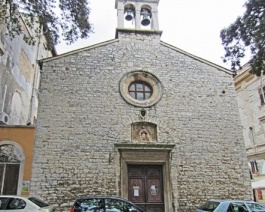

The Church of Our Lady of Mercy, known locally as Crkva Gospe od Milosti or Chiesa della Misericordia, is a historic votive church nestled in the heart of Pula's old town, Croatia. Dedicated to the Virgin Mary under her title of Mercy (Misericordia), it stands as a poignant symbol of medieval piety and urban spirituality in this Roman-founded city on the Istrian Peninsula. Built in the late 14th century following a reported Marian apparition, the church has served as a focal point for devotion, community gatherings, and education for over six centuries. Its modest yet evocative presence on Dante Alighieri Square (Danteov Trg) integrates seamlessly with Pula's layered history, from Roman streets to Venetian influences. Today, it remains an active parish church, hosting masses, processions, and cultural events, while embodying the city's role as a crossroads of Christian traditions in the Adriatic region.
The church's origins are steeped in legend and documented piety, tied
to a miraculous apparition of the Blessed Virgin Mary. According to
cathedral parish archives, the event occurred on October 10, 1383 (or
1389 in some accounts), at the site's location in the medieval urban
core, prompting the construction of a votive chapel as an act of
thanksgiving and protection. This apparition is commemorated annually on
October 10 with solemn masses and processions, underscoring the church's
enduring role as a pilgrimage site within Pula. The structure was first
referenced in historical records around this period, reflecting the
spiritual fervor of late medieval Istria under Venetian rule, when
Marian devotion surged amid plagues and wars.
From 1453 to 1780, the
church and an adjacent monastery were entrusted to the Augustinian
order, who expanded its pastoral reach. An Augustinian hospice operated
beside it from 1600 to 1814, providing shelter and care during times of
hardship, including the Napoleonic era and Austro-Hungarian
administration. The church endured a devastating fire in 1858, which
damaged its interior but spurred immediate restoration efforts. In 1898,
Trieste-based architect Tomasi proposed a grand expansion to accommodate
growing congregations, but financial and logistical challenges limited
the work to a new presbytery and sacristy, preserving much of the
original medieval fabric. Further restorations occurred in 1980 and
2015, focusing on structural integrity and aesthetic renewal without
altering its historical character.
The church's history mirrors
Pula's turbulent past: as Pietas Julia under Rome, a Byzantine outpost,
and a Venetian stronghold, it adapted to shifting powers while
maintaining its devotional core. In the 20th century, it became
intertwined with local education; its eastern facade abuts OŠ Centar,
Pula's oldest school (built 1867 for children of Austro-Hungarian navy
families), where joint masses mark the school year. Recent celebrations,
such as the 2022 feast day led by seminary vicar Rev. Jurica Manzoni,
highlight themes of mercy and rebirth, drawing parallels between the
apparition and contemporary spiritual needs.
Though modest in scale compared to Pula's grand Roman Arena or
Cathedral, the Church of Our Lady of Mercy exemplifies late Gothic
vernacular architecture adapted to Istrian stone traditions. Measuring
approximately 20-25 meters in length (exact dimensions vary in sources
due to partial expansions), it features a simple rectangular plan with a
single nave, typical of 14th-century chapels in the region. The facade,
facing Dante Alighieri Square, is unadorned yet dignified, crowned by a
statue or relief of the Madonna della Misericordia—depicting the Virgin
sheltering the faithful under her mantle—a common iconographic motif
symbolizing protection and intercession. This portal sculpture, visible
in historical photographs, evokes the protective aura of the apparition
site.
The church's orientation aligns with Pula's ancient Roman grid:
its lateral wall follows the Cardo Maximus (a north-south axis, now part
of the old town's pedestrian paths), while the rear abuts the Decumanus
Maximus (east-west, modern Ulica Sergijevaca, a bustling shopping
artery). This integration positions it as the "spiritual heart" of the
city, bridging antiquity and faith. Internally, the space is intimate,
with whitewashed walls accentuating wooden elements and a main altar
housing a revered statue of the Virgin Mary, transferred from earlier
iterations of the site. The 1898 additions—a enlarged presbytery for
liturgical functions and a sacristy for clerical use—introduce subtle
neoclassical touches, such as arched doorways and vaulted ceilings,
contrasting the original Gothic pointed arches and ribbed vaults.
Acoustics and natural light enhance its contemplative atmosphere: narrow
windows along the nave filter Adriatic sunlight, casting ethereal glows
during evening masses. The bell tower, if present, is understated,
blending into the urban skyline without dominating like the nearby
Cathedral's Baroque spire. Renovations have preserved original stone
masonry from local quarries, resistant to Istria's humid climate, while
modern interventions ensure seismic stability. No elaborate frescoes or
altarpieces are noted, emphasizing humility over opulence, though votive
offerings from pilgrims may adorn side chapels.
As a testament to Marian devotion and communal resilience, the Church
of Our Lady of Mercy holds profound cultural and spiritual significance
in Pula, a city famed for its Roman heritage yet vibrant in Christian
continuity. It represents the "small-scale sacred" amid grand
antiquities, offering a quiet counterpoint to tourist throngs at the
Arena. Its apparition legend fosters a sense of ongoing miracle,
attracting locals for feast days and visitors seeking authentic Istrian
piety. Architecturally, it contributes to Pula's UNESCO-nominated
historic ensemble, illustrating how medieval faith overlaid Roman
infrastructure.
The church is open daily for prayer, with masses in
Croatian (check local schedules via the Pula Cathedral parish at +385 52
222 538 or biskupija-porecko-pulska.hr). Entry is free, though donations
support maintenance. Located at Danteov Trg 1, it's a 5-minute walk from
the main bus station or Arena, ideal for self-guided old-town tours.
Nearby, explore the adjacent school, Sergijevaca's shops, or the Temple
of Augustus. For deeper insights, join October 10 celebrations or guided
walks via the Tourist Office Pula (pulainfo.hr). As of 2025, no major
disruptions are reported, but verify for events. This unassuming gem
invites reflection on mercy in a historic crossroads, much like the
apparition that birthed it.